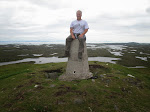Green Heron – Red Wharf Bay, Anglesey, 16th November 2005
Later on on Wednesday the 16th November 2005 (having already duly banged in the Black Scoter at Llanfairfechan, as described in an earlier post https://collapsedbirder.blogspot.com/2023/06/black-scoter-off-llanfairfechan-gwynedd.html ) it was urgently back to the car and onwards to hopefully make it a two-bird day by doing the same with the Green Heron at Red Wharf Bay on Anglesey.
This had turned up there on Monday the 7th November 2005 (although it had probably been around for at least eight days before it was first reported). It had also been proven that this bird was the same one that had previously been seen at Schull in County Cork, Ireland between the 11th and 13th October 2005.
Time was of the essence; it was mid-November and so days were short and it was already reasonably late in the afternoon. I also had to get back to somewhere appropriate before Gary, Chris, Steve and I met up to go to Cologne for the weekend.
I managed to navigate and drive my way from Llanfairfechan to Red Wharf Bay without too many problems. On arrival I then managed to find the appropriate place to park. Then all I had to do was locate the bird, somewhere out in the salt-marsh creeks.
Again recollections beyond the very basic are minimal to say the least. Like at Llanfairfechan I think I was well and truly on my own, at least in terms of other birders. There may have been one or two but I really cannot remember. However, I think I can vaguely remember that there were locals walking and dog-walking alongside the salt-marshes and it just might have been the case that they shared their own inside information; the bird had been around for a considerable while by then and was something of a local cause celebre. I also dimly remember that I may not have had on the most appropriate footwear for the circumstances – I probably hadn’t considered it a priority to change my shoes, although these weren’t necessarily the best for tramping around the salt-marshes.
Whatever, I reasonably quickly and easily located the bird and spent some while following it (or attempting to get ahead of it to take photographs, as it was surprisingly close in the salt-marsh creeks). It moved very quickly though, so it wasn’t easily to keep up with (or take photographs of!).
I did so reasonably successfully though.
It was a small heron with a large bill. The upper-parts were mainly a dark browny-green with hints of iridescence. The cap was dark and separated from the back and wings by a rufous collar. The under-parts were a rufous (brick) red especially on the side of the neck and the upper breast, which was streaked with pale lines. The lower breast was white and streaked with rufous lines. The coverts had pale fringes. The bill was mainly dark grey although the lower part of the lower mandible was orange. The legs were greeny-yellow.
Seemingly, this bird was again (like the Black Scoter) the sixth individual ever to be recorded (although this includes a record from 1889 and a bird that was seen on both Jersey and Guernsey in the Channel Islands). In a curious way, it was long-term redemption; just months after I graduated from the University of Hull in 1982 just the second ever Green Heron turned up at Stone Creek in Holderness in late-November, but at the time I had just no idea about rare birds and quickly getting news about (and twitching) them. In some ways I regret never being part of the whole Nancy’s grapevine thing. As such, it wasn’t until the advent of Birdline in the 1980s that I could readily access such information. And then it was a downhill slope, as evidenced by these tales!





No comments:
Post a Comment